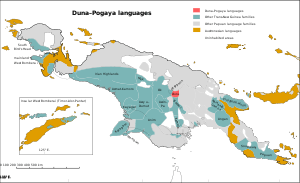Duna–Pogaya languages
The Duna–Pogaya (Duna–Bogaia) languages are a proposed small family of Trans–New Guinea languages in the classification of Voorhoeve (1975), Ross (2005) and Usher (2018), consisting of two languages, Duna and Bogaya, which in turn form a branch of the larger Trans–New Guinea family.[1] Glottolog, which is based largely on Usher, however finds the connections between the two languages to be tenuous, and the connection to TNG unconvincing.[2]
| Duna–Pogaya | |
|---|---|
| Duna–Bogaia | |
| Geographic distribution | Hela Province, Papua New Guinea |
| Linguistic classification | Trans–New Guinea
|
| Subdivisions |
|
| Glottolog | None |
 Map: The Duna–Pogaya languages of New Guinea
The Duna–Pogaya languages
Other Trans–New Guinea languages
Other Papuan languages
Austronesian languages
Uninhabited | |
Language contact
Duna has had significant influence on Bogaya due to the socioeconomic dominance of Duna speakers over the less populous, less influential Bogaya speakers.[3] Duna also has much more influence from Huli (a widely spoken Trans-New Guinea language) at 27–32 percent lexical similarity with Huli, while Duna has only 5-10 percent.[3]
Pronouns
Pronouns are:
sg du pl 1 *nó *ge-na *i-nu 2 *gó 3 *kó *ki-nu
Evolution
Duna reflexes of proto-Trans-New Guinea (pTNG) etyma are:[3]
- amu ‘breast’ < *amu
- konane ‘ear’ < *kand(e,i)k(V]
- kuni ‘bone’ < *kondaC
References
- NewGuineaWorld
- Hammarström, Harald; Forkel, Robert; Haspelmath, Martin, eds. (2017). "Bogaya". Glottolog 3.0. Jena, Germany: Max Planck Institute for the Science of Human History.
- Pawley, Andrew; Hammarström, Harald (2018). "The Trans New Guinea family". In Palmer, Bill (ed.). The Languages and Linguistics of the New Guinea Area: A Comprehensive Guide. The World of Linguistics. 4. Berlin: De Gruyter Mouton. pp. 21–196. ISBN 978-3-11-028642-7.
- Ross, Malcolm (2005). "Pronouns as a preliminary diagnostic for grouping Papuan languages". In Andrew Pawley; Robert Attenborough; Robin Hide; Jack Golson (eds.). Papuan pasts: cultural, linguistic and biological histories of Papuan-speaking peoples. Canberra: Pacific Linguistics. pp. 15–66. ISBN 0858835622. OCLC 67292782.